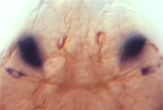Marine Worm Has Insectile and Vertebrate 'Eyes'

How did a complex structure like the human eye evolve? Charles Darwin recognized that the eye would be a real test of the theory of evolution. He suggested that it might be possible to evolve an eye from "imperfect and simple" forms:
"To suppose that the eye, with all its inimitable contrivances for adjusting the focus to different distances, for admitting different amounts of light, and for the correction of spherical and chromatic aberration, could have been formed by natural selection, seems, I freely confess, absurd in the highest possible degree.
"Yet reason tells me, that if numerous gradations from a perfect and complex eye to one very imperfect and simple, each grade being useful to its possessor, can be shown to exist; if further, the eye does vary ever so slightly, and the variations be inherited, which is certainly the case; and if variation or modification in the organ be ever useful to an animal under changing conditions of life, then the difficulty of believing that a perfect and complex eye could be formed by natural selection, though insuperable by our imagination, can hardly be considered real."
Scientists today believe that the eye could evolve from a single light-sensing cell. Scientists disagree over whether it evolved just once, or many times.
It turns out that Nature is both creative and generous with her gifts. Recent research has shown that the tiny marine worm Platynereis dumerilii has two types of light-sensing cells. The eyes of the worm have rhabdomeric photoreceptors, a compound lens formation that is seen almost exclusively in insect eyes. Rhabdomeric photoreceptors are covered in little finger-like protrusions. In its brain, however, it has a different kind of light-sensing cells - ciliary cells that are seen in vertebrate animals. Ciliary cells have hair-like cilia that extend outward and branch out like tiny umbrellas. Two different ways of sensing light in a single organism!
Researcher Joachim Wittbrodt of the European Molecular Biology Laboratory in Heidelberg, Germany speculates that the ciliary cells may regulate the worm's daily activity cycle, saying "We think they are related to circadian rhythms. We have found that there is a direct connection to the area used for locomotion... In the beginning we had a toolbox... what was in the brain in the worm ends up in our eye." If the animal had two copies of the genes needed to make one kind of photoreceptor, speculates Wittbrodt, then the extra set would have been free to evolve into the other photoreceptor. Different animals would subsequently evolve to use the two options in different ways.
Science fiction authors do not have the constraints of being able to use only Earth DNA; they are free to imagine light-sensing cells in wildly different ways. Here is a small sample of the variety found in sf:
His sense organs were gathered in clusters at the site of a man's ears; his visage... was corrugated muscle, not dissimilar to the look of the uncovered human brain. [The Meks from The Last Castle by Jack Vance]
Facing him from the middle of the room was something neither human nor humanoid. It stood on three legs, and it regarded Louis Wu from two directions, from two flat heads mounted on flexible, slender necks. Over most of its startling frame, the skin was white and glovesoft; but a thick, coarse brown mane ran from between the beasts necks, back along its spine, to cover the complex-looking hip joint of the hind leg. The two forelegs were set wide apart, so that the beast's small, clawed hooves formed almost an equilateral triangle. Louis guessed that the thing was an alien animal. In those flat heads there would be no room for brains. But he noticed the hump that rose between the bases of the necks, where the mane became a thick protective mop... and a memory floated up from eighteen decades behind him.
This was a puppeteer, a Pierson's puppeteer. Its brain and skull were under the hump. It was not an animal; it was at least as intelligent as a man. And its eyes, one to a head in deep bone sockets, stared fixedly at Louis Wu from two directions. [The Puppeteers from Ringworld by Larry Niven]
"Its body architecture has been redesigned for greater efficiency, our useless simian hangovers have been left out, and its organs have been rearranged in a more sensible fashion...You can't say its not human, for it is .. an improved model. Take that extra appendage at the wrist. That's another hand, a miniature one... backed up by a microscopic eye. You can see how useful that would be, once you get used to the idea..." [The genetically-modified humans from Methuselah's Children by Robert Heinlein]
Image at top: Platynereis dumerilii
(This Science Fiction in the News story used with permission from Technovelgy.com - where science meets fiction.)
Get the world’s most fascinating discoveries delivered straight to your inbox.


